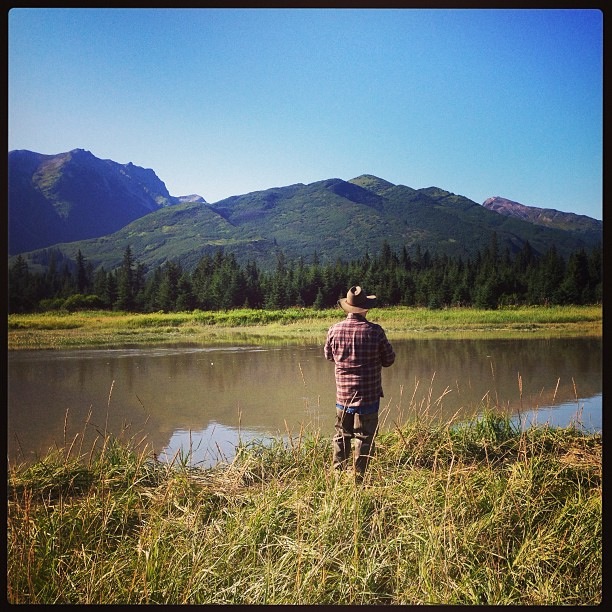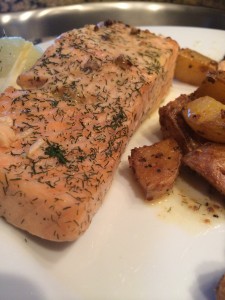Salmon: Wild versus Farmed

There is nothing like the beauty of Alaska, fishing quietly – if you think you know Zen you don’t til you are here
Growing up in the salmon capital of Alaska, Ketchikan, where many made their living as commercial fisherman, it is easy to understand why I would have a bias toward wild salmon caught from Alaska. It wasn’t always that way – in fact, growing up I hated salmon – but that is another story. For now, lets skip my love affair with the most amazing food in the world.
Complete with the prejudice came the propaganda about farmed salmon – and armed with those it was easy to think that there was only one real salmon to enjoy – the lovely, albeit expensive wild Alaska salmon.

Perhaps it was the skills with a knife I learned with salmon that led me to be a surgeon
Then in eastern Ontario my family wanted salmon for dinner. The salmon in the grocery store looked lovely – it was fresh, smelled like the ocean, had great color, and was 1/3 the price of what I would pay for salmon in the states.
The first night- grilled salmon – prepped it simply with seasoning, pepper, and some lemons. Thinking I would only have a bite or two, I was surprised by the flavor of it: fresh tasting, as if it had been caught only a few hours before. The balance of the lemons gave the oily nature of the fish a foil, and the simple salmon was consumed almost to the bone.
Two nights later I noticed that the grocery store had salmon on a cedar plank – for $7 per serving (six ounce serving), and nicely placed on the plank which was soaked from the fish. Placed on the grill and watching the lovely soaked cedar give up smoke that would gently flavor the fillet. The smell of the cedar smoke reminded me of planked salmon in Alaska.
Anxious to try the first bite, afraid to get my hopes up too high – the salmon was delicious. Not a king flavor, more of a cross between a red and a silver – but salmon.
When the veil of prejudice lifts, one begins to investigate the propaganda to see if those old “assumptions” have any merit. The first didn’t; the fish tasted great.
Common Myths About Farmed Salmon
(1) That farming practices cause negative environmental impact. They can – the usual one listed is that the large biomass of salmon raised in the pens – meaning lots of salmon poop in an area. If anyone has seen the salmon run in Alaska, the biomass of salmon is larger than the amount of salmon in a pen. Somehow Mother Nature recovers from the five wild runs up the smallest creeks. The other is the concern about the feed that isn’t consumed by the fish and falls to the bottom of the ocean. The filter feeders are happily consuming leftovers, much as they always do.
(2) They use artificial colors to make them pink. They don’t use red dye number two – they use the same beta-carotene that the wild salmon pick up from the crustaceans they eat. No difference
(3) Some escape from the pens and will compete with wild salmon. Some do, but even when British Columbia tried to introduce the Atlantic salmon to their waters in the 1920’s they were unsuccessful. The Atlantic salmon dont live there.
(4) Sea lice infect the farmed fish and then become a problem for native fish fry. The sea lice come from native stocks, and if found in farm raised salmon are eliminated with antibiotics. They do not endanger the native salmon hatchlings
(5) They use antibiotics to help salmon grow – producing a risk of antibiotic resistant organisms in people. First, they dont, and second – the bacteria that infect fish are not the same that infect humans. While land animals have been the source of many outbreaks of infectious disease between humans, the fish are too far removed on the evolutionary scale. The antibiotics used are not ones that would be used in humans or land animals.
(6) They are genetically modified – well, not yet, and even if they are bred to grow larger faster, this is still not an issue for humans.
(7) They have high levels of PCBs . They no longer do – they did ten years ago, but the feed has changed and levels now are equivalent to wild salmon – and continue to decline. In addition there is no increase in mercury or other industrial pollutants.
Atlantic farm-raised salmon have higher levels of omega-3 fatty acids than wild salmon. They are a lean protein, and a great source of micronutrients for humans. The levels of industrial pollutants.
The salmon is available year round, it is inexpensive.

This is the Copper River Rip Off – gouging people for the wild Alaskan Salmon. This weekend, when it doesn’t sell it will be half the price.
Hard to change the mind of an Alaska Native — but salmon speaks

Tonight’s dinner- a lovely salmon with pineapple glaze (because I’m fancy)
